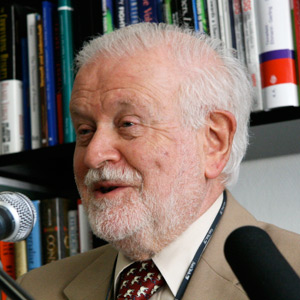I have served in five different positions under both Republican and Democrat administrations and have had some modest success in cutting authorized spending. But the experience has been difficult and has caused me some personal problems. I am afraid this will be the case for anyone who tries to cut spending—in the face of an entrenched bureaucracy that thrives on ever-increasing budgets.
It may also be a generational problem, shared by many of my age group who have lived through difficult times before WW-2. As a result of such experience and upbringing, I also tend to be somewhat frugal—unlike most of the younger generations. I turn off lights; my children don’t.
My first encounter with government was when I enlisted in the U.S. Navy during WW-2. I think my monthly “salary” was $30. And we were encouraged to buy War Bonds—which we did.
During the 1950s, at the University of Maryland, I benefited greatly from large government budgets for scientific research in atmospheric and space physics. But in 1962 I became the founding Director of the U.S. Weather Satellite Service, part of the U.S. Weather Bureau-Department of Commerce, (now NOAA), and in charge of what was then considered a huge budget, mainly for purchasing weather satellites from NASA.
We started with the low-cost TIROS, a simple spin stabilized satellite, which provided day-time cloud pictures through a television camera. In those years, NASA was developing the much more advanced NIMBUS satellite, which was completely stabilized and carried many other instruments. It was a great scientific effort but much too ambitious for the kind of operational weather forecasting that was needed at the time. We tried to tell this to NASA but they wanted us to commit to use NIMBUS as an operational satellite before it was even flight-tested.
A big fight developed between the Weather Bureau and NASA, which reached all the way to the White House. With the support of Assistant Secretary of Commerce, J. Herbert Hollomon, I canceled our NIMBUS purchase order to NASA—something that had never been done before. The Management School of Syracuse University even produced a study (a thesis by Robert Carpenter) that recounted the whole story as an example of technical management in government. I left my government position in 1964 for academia, pleased that I was able to cut the budget in half. I didn’t realize at the time that this would come back to bite me; the bureaucracy never forgets or forgives.
My next government job, 1967 to 1970, was as Deputy Assistant Secretary of Interior for water quality and research. It was a rather peaceful job; one of my main tasks was to direct the “National Estuarine Pollution Study,” designed to figure out how to harmonize the many uses of valuable estuaries—ranging from ports and shipping, cooling of power plants, all the way to harvesting oysters and shrimps. We concluded that the common feature was water quality, to be achieved by proper treatment of sewage pollution, agricultural run-off, and control of eutrophication. Yet when our report landed with Congress it became the Coastal Zone Management Act—yet another large government grant program.
When EPA was set up in 1970, I became Deputy Assistant Administrator for Policy. Being young and ambitious, I approached administrator Bill Ruckelshaus and suggested that I might be a good deputy administrator. I pointed out the need for cost-benefit analysis in deciding just “how clean is clean.” His answer, as a lawyer, was “Our job is to enforce the law, get after these polluters, and sue them.” I decided that EPA was not for me and moved to the University of Virginia.
But in 1974, during the Ford administration, I was interviewed for the job of Assistant Secretary of State for Oceans, Environment, and Science. OES had not one but three deputy assistant secretaries and lots of staff people, and really did not produce anything except perhaps some briefings for the secretary. I never met Henry Kissinger but I suggested to Under-secretary Ingersoll during the interview how the office might be streamlined. I did not get the job; OES was used mainly as a convenient parking place for foreign-service officers who didn’t have an assignment. So back to the University of Virginia.
The Reagan Years
When Reagan came to the White House, my name was put forward for the position of NOAA Administrator. But Lowell Weicker, a Republican senator from Connecticut, put a “hold” on my nomination. Our interview was quite unsatisfactory. It seems he got his information about me from people at the weather satellite center who were unhappy about my earlier budget cut. It taught me an important lesson about how life works in the federal government.
The Reagan White House then appointed me as Vice-chairman of NACOA (National Advisory Committee on Oceans and Atmosphere). We were supposed to oversee NOAA and other government activities dealing with oceans and atmosphere, and make recommendations. Our group made several suggestions for privatizing much of what NOAA does, which would have saved a great deal of money and cut federal budgets. NACOA was soon disestablished and funding was cut off for the staff. End of story.
My next adventure was in the Department of Transportation. In 1987 I was appointed as Chief Scientist and given general responsibility for overseeing the procurement of a new FAA air-traffic control system. The budget of $26 billion was then the largest civilian procurement ever planned. It took a while to figure out what the system was about, but I soon discovered that one could kill the $6 billion program for MSL (Microwave Landing System). A favored FAA proposal for nearly two decades, it had become technically redundant, partly because of improvements in the existing landing system and partly because of the advent of GPS satellites.
I found that it was always easier to cut something than to start something in the federal government—particularly if one had the support of the secretary, in this case Jim Burnley. But I lost some friends in the FAA.
When Reagan left office, Sam Skinner was appointed as DOT Secretary. He bought me lunch and put his arm around me: “Fred, I don’t think we need a chief scientist.” Apparently, my efforts to cut the FAA budget had become known to him. I left in 1989 and returned to the University of Virginia.
Space and Defense
A special word about the space agency. Though a space scientist, I have never actually worked for NASA, but was considered for the position of Chief Scientist by NASA heads Jim Fletcher in 1989 and by Mike Griffin in 2001. But perhaps my views about certain NASA programs had become known to them.
I have always considered the International Space Station as a big ‘White Elephant’—and the manned-moon base of George Bush the elder and George W. Bush an even bigger disaster. Needless to say, I did not get the NASA job.
I still consider the space station to be a fairly useless enterprise. And I argue strongly against space colonization. At the same time, there are a very few good applications for “man in space.” My particular interest is in setting up a manned laboratory on the Martian moon Deimos and explore Mars solely with unmanned rovers. I view with horror any plan to set up a manned base on Mars itself.
The Climate Battles
My most recent experience dates to 2005, when the White House put forward my name as Assistant Secretary of Commerce (and Deputy NOAA Administrator) to supervise the burgeoning federal program of climate-science research. I passed my interviews with flying colors; but then the White House lost interest. Obviously, my well-known skepticism about man-made global warming had reached the political types and the matter just died.
Too bad. During the last decade, we have spent some $50 billion on climate-related research, much of it through the inter-agency Climate Change Science Program (CCSP). The office I was supposed to direct finally issued 21 reports, which are of dubious value and hardly known. The first and most important of these, CCSP-SAP 1.1, actually demonstrates that nature, not human activity, rules the climate. The “fingerprints” of observations and greenhouse models disagree completely—as is evident from the graphs in the body of the report. Yet the Executive Summary, written by political types and approved by NOAA management, manages to gloss over the disparity and maintains the fiction of anthropogenic global warming. Had I been in charge, this Summary would not have been approved.
Currently, Congress is trying to cut some of the more egregious programs that are based on fears about catastrophic climate change. Witness the Energy Tax Prevention Act that would stop the EPA from mandating job-killing emission limits for carbon dioxide. Or the efforts to eliminate a whole slew of subsidies for uneconomic projects for “renewable” energy.
Conclusion
So what’s to be done? The political appointees soon get frustrated when they realize how difficult it is to change course. We need lots of mid-level managers who are not afraid to put their jobs on the line. The bureaucracy is steeped in a culture of automatic annual increases—and new programs. The American public and also the states have become used to government grants, subsidies and services; there are more than 1,000 federal grant-in-aid programs for states, involving education, housing, transportation, etc. Most of these federal services can and should be replaced by locally funded and controlled ones—closer to the voters and taxpayers, and less costly. However, there is need to take slow steps in cutting the federal budget; withdrawal symptoms can be painful, politically damaging, and could kill the whole enterprise. Remember that “pulling pigs out of the trough causes a lot of squealing.”









